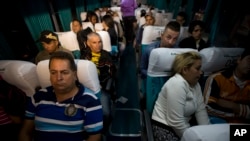After more than three months stranded in Costa Rica, 180 of the 8,000 Cuban migrants trapped there finally began their long-awaited trip north toward the U.S. border, flying into El Salvador and then travelling by bus to Guatemala on Wednesday.
The first pilot flight took off from Costa Rica's Daniel Oduber airport in the northern city of Liberia late Tuesday night as part of a regional agreement to overcome Nicaragua's refusal to let them through by land.
The migrants appeared to get special treatment along the way: They were greeted by El Salvador's foreign minister upon their arrival in that country even as, when they got to the Guatemalan border, they saw a busload of Salvadoran migrants headed the other way after being deported back to their home country from the United States.
The Cubans won't have to worry about that since U.S. immigration policy that allows them to stay if they reach the United States. That special status initially raised some resentment in Central America, whose citizens are often deported from the U.S. if they enter without visas.
But the Cubans' trip was so far smooth. Private, chartered transportation and transit visas had already been arranged for them.
Four rented buses brought the Cubans to the Pedro de Alvarado crossing on Guatemala's border with El Salvador. Human rights activists accompanied them.
Ruben Chil Cruz, who left his wife and two children behind in Cuba, said "It has all been very quick, thank God."
However, Chil Cruz said he wasn't sure exactly, once he reaches the Mexican border, how he would cross that country, known for vicious attacks on and kidnappings of migrants, especially those from Central America. He said he didn't plan to use a smuggler to cross Mexico and hoped Mexican immigration officials at the border could give him advice on how to travel to the U.S. border. From there, he said, he plans to travel to Miami.
But he expected the trip to be quick. "I think I will get to the United States by Sunday," he said.
For most Central American migrants, the trip takes weeks, and sometimes months.
The Cubans once got through even faster, but Nicaragua — an ally of Cuba — closed its border to Cubans leaving the island on Nov. 13. Most Cubans came to Panama and Costa Rica via a longtime air bridge through Ecuador, before that South American country began demanding visas for Cubans in December.
This month, the three Central American nations and Mexico reached an agreement on an air bridge to get around Nicaragua's refusal to let the Cubans through.
There has been an exodus of migrants from Cuba in recent months after the communist-run country loosened requirements for leaving. Many potential migrants in Cuba are also worried that the re-establishment of relations between the United States and Raul Castro's government could their privileged immigration treatment in the United States.
On Tuesday, some of the Cubans selected for the first flight from Costa Rica expressed joy that they would finally be on their way.
"They told me four days ago and I still don't believe it, I didn't expect to be in the first group," said Lislenia Fernandez, who arrived in Costa Rica from Panama on Nov. 8 with her husband Yordani Casanova. "I'm happy because I can travel with my husband."
Fernandez hopes to get to Miami, where her brother-in-law is, but she had to leave behind her sons aged 4 and 8. "We are going to look for a way to bring them over."
Arnobis Tellez left behind three children and a grandchild in Cuba. Like Chil Cruz, he wasn't sure how he would cross through Mexico.
"These last months have been terrifying, because nobody thought this was going to happen," Tellez said. "We thought that by this time we would all be in the United States."
Salvadoran Foreign Minister Hugo Martinez said he wished all migrants in the region had such a happy story.
"With this action (for the Cubans) we are showing dignified treatment and respect for human rights, which are things that the administration of El Salvador's president ... is asking for our own migrants."







